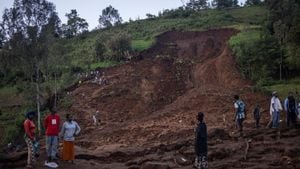Scientists have uncovered remarkable evidence at the shores of Lake Turkana, Kenya, shedding new light on human evolution. This groundbreaking discovery, stemming from years of research and excavation, reveals the coexistence of two different hominin species—Homo erectus and Paranthropus boisei—1.5 million years ago, illustrating how these ancient humans shared habitats and possibly interacted.
This significant find began in 2021 when paleoanthropologists, led by renowned researcher Louise Leakey, initially sought human fossils buried deep within sediment. Instead, they stumbled upon gigantic bird footprints. Yet, among these more unusually sized prints, they managed to identify hominin footprints which fascinated the entire scientific community. The presence of these fossilized tracks indicates not just the existence of these species at the same time but also their spatial proximity to each other on the same surface.
The first milestone was the identification of two parallel footprints left by Homo erectus and Paranthropus boisei discovered just one meter apart. According to researcher Kevin Hatala from the Max Planck Institute for Evolutionary Anthropology, this suggests they potentially crossed paths within hours or perhaps days, which opens up numerous avenues of inquiry concerning their interactions. This was documented formally on November 28, 2024, when the scientific world received this stunning evidence published in the prestigious journal Science.
What’s fascinating is the evolutionary significance of this site; it provides one of the earliest snapshots of distinct hominins coexisting and potentially competing or cooperating. Louise Leakey emphasized how this finding gives researchers new insights not only about the biomechanics of these early humans but also their possible interactions within the lush environments by the lake.
Dr. Kevin Hatala, who also spearheaded the three-dimensional analysis of these prints, described the footprints as dynamic evidence. They reveal different styles of walking, illustrating not only the anatomical diversity of these hominins but hinting at their adaptive behaviors reflecting their ecological niches. P. boisei, with its unique jaw structure, was likely engineered for resilience against tougher vegetation compared to the more versatile and omnivorous Homo erectus.
Investigators employed advanced 3D scanning technology to precisely analyze the footprints, comparing them against hundreds of contemporary human prints. This innovative approach allowed them to distinguish between species and the mechanics of their movement, something traditional fossil analysis often overlooks.
The lake shore itself was once teeming with wildlife, including giant storks and various other animals, presenting both opportunities and threats to these hominins. This coastal setting might have served as common ground for different species, sparking the curiosity of scientists eager to learn how Homo erectus and Paranthropus boisei cohabitated and adapted to their environment.
Another driving force behind this research is the recognition of the importance of trace fossils such as footprints. Unlike body fossils, which can be easily displaced, footprints remain fixed, providing clearer narratives about the behavior of organisms as they navigated shared landscapes. Craig Feibel, another key contributor to the research, pointed out how these findings proposed significant insights related to how ancient species interacted socially and competitively.
Moving forward, Hatala and his colleagues are enthusiastic about exploring various unanswered questions. They speculate about what might have lured both species to the hazardous lake margins, which were not only fertile grounds for hunting or foraging but also posed risks from local wildlife, including hippos and crocodiles. Their investigation may pave the way for future research bridging anthropology, paleontology, and ecological studies.
Previous assumptions held by researchers often presented human evolution as linear, emphasizing the triumph of one species over another. Yet, what’s clear from this latest study is the complexity of our evolutionary history, underscoring diversity and coexistence rather than simply conflict. According to various experts, these footprints symbolize much more than mere survival—they tell the story of different adaptations and ecological strategies influencing the fate of entire species.
While the exact nature of relationships between Homo erectus and Paranthropus boisei remains to be fully understood, the depth of learning facilitated by this discovery cannot be understated. Future studies could yield even more tantalizing insights about how early humans lived, thrived, and interacted with one another millions of years ago. This significant discovery may very well be just the beginning of major developments for the study of human evolution.
With its far-reaching impacts, this fascinating research invites both scientists and history enthusiasts alike to ponder the multiple storylines woven through the fabric of human ancestry, grounding the narrative firmly on the shores of Lake Turkana, where our prehistoric relatives once walked under the same sun.



